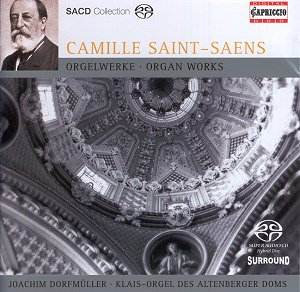Altenberg Abbey, once
the largest Christian Church in the
world, was largely destroyed during
the French Revolution and the ensuing
wars. It was partially restored in the
nineteenth century with funds contributed
by the Prussian King Friedrich Wilhelm
IV on condition that the restored church
would be available for use by both Catholics
and Protestants. It wasnít until 1980
that the organ was installed.
The St. Martinís organ
has an unusual history. Built as a Romantic-voiced
organ in 1912, in 1962 it was revoiced
in an attempt to make it a Baroque organ,
and then in 2001 it was restored to
enhanced Romantic splendor, with a bombarde
stop replacing the Rückpositiv.
The organ also, along with most modern
instruments, has a MIDI interface allowing
complete concerts to be recorded and
played back on this or on another organ
with a MIDI interface.
The Breton melody in
the Rhapsody turns out to be
the tune from Smetanaís Die Moldau.
How the tune got from Bohemia to Brittany,
or vice-versa is not explained, but
clearly European folksongs traveled
long distances. How else did a Hungarian
song get to be the national anthem of
Canada?
The problem with these
disks is the music. We love Saint-Saëns
largely because he was a great tunesmith,
but his organ works are built on rather
bland musical material, worked with
some skill, to be sure, but to what
effect? Everyone seems to agree that
his greatest organ works are the Prelude
and Fugue Op. 99 No. 3, the Fantasie
in E flat and maybe the Improvisation
Op. 150 No. 7; but, however well
they are played and recorded on these
two disks, they remain uninteresting.
You canít blame the performers. I have
the scores to this music, and once tried
to play it myself, but was unable to
generate any enthusiasm for it, and
now I feel vindicated that these fine
artists can make no more of the music
than I could.
Note that the playing
times are quite different between these
two recordings. The correct tempo
for playing a specific organ is of course
determined by the reverberant characteristic
of the hall and to some extent by how
the microphones are placed for recording.
The Altenberg organ is bright and clear
with the reverberation providing a halo
of space around the sound. The
St. Martinís organ has a deep reverberation
which tends to bloom, to grow.
Hence complex rapid passages must be
played more slowly or they will be jumbled,
whereas the Altenberg organ permits
rapid passage-work to be heard clearly.
Both artists work skilfully with the
palette with which they are presented
Saint-Saëns was
a very popular performer. After he had
officially retired, he decided he wanted
the experience of playing before an
audience once more, so he offered to
play (I recall reading) the Schumann
Concerto with a small provincial orchestra
on condition that they keep his name
a total secret. The day of the concert
arrived and the mystery pianist appeared
only to discover that there had been
an information leak, and the small hall
was overwhelmed with thousands of cheering
people who had come great distances
to hear their idol perform once more.
So one is justified in believing that
in the hands of the composer these pieces
came brilliantly to life. But as they
stand theyíre less interesting than
second-rate Hindemith or Reger.
Can we love third rate
music by a favorite composer out of
sentimental value, thinking that we
are somehow close to his heart, thinking
he is more accessible when he isnít
being "great"? These disks
feature both beautiful organ playing
and beautiful sound, but Saint-Saëns
would have been better served by an
anthology of his best two or three pieces
coupled with works by Reger, Widor,
Liszt and maybe even Franck. This would
have made an "interesting"
concert showing the confluence of musical
styles at the time.
Paul Shoemaker
see also review
by Dave Billinge


